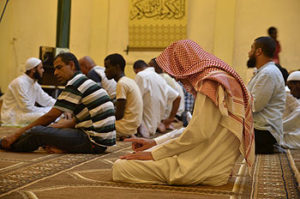 PRACTICE OF THE MUSLIM RELIGION IN CUBA. THE CORÁN.
PRACTICE OF THE MUSLIM RELIGION IN CUBA. THE CORÁN.
Readings from the Corán, the Islamic veil and the prayers oriented towards Mecca are increasingly frequent in Cuba, where the Muslim community has been growing in recent years.
Last year, Imam Yahya, of the Sunni branch and president of the Cuban Islamic League closest to the ruling party, estimated that about 5,000 Cubans converted to Islam. The current mosque located on Oficios Street has become a meeting point attended by African students and diplomats based in the Island. Prayer centers have also appeared throughout the country and in cities such as Santa Clara, Santiago of Cuba or Camagüey there are small Muslim communities.
In the next few years one of the largest mosques in Latin America will be completed in the capital, which is expected to accommodate some 10,000 Muslims and will be financed by Saudi Arabia.
However, “it is one thing for Cubans who have converted to Islam and quite another for those who live attached to the teachings of Muhammad,” said Yasser, a 52-year-old newspaper resident in the Cerro municipality.
“As in other religions that are practiced in Cuba there are many simulations and double faces in this,” laments this Havana man. “In my neighborhood we are at least three families of Lebanese origin,” he says, but he complains that many of the Cuban Muslims he knows “in the morning go to the mosque and at night they drink rum or dance reggaeton”.

PRÁCTICA DE LA RELIGIÓN MUSULMANA EN CUBA. EL CORÁN.
Las lecturas del Corán, el velo islámico y los rezos orientados hacia La Meca son cada vez más frecuentes en Cuba, donde la comunidad musulmana ha estado creciendo en los últimos años.
El año pasado, el Imán Yahya, de la rama sunita y presidente de Liga Islámica Cubana más cercana al oficialismo, cifraba en unos 5.000 los cubanos convertidos al Islam. La actual mezquita ubicada en la calle Oficios se ha convertido en un centro de encuentro al que acuden estudiantes africanos y diplomáticos radicados en la Isla. Los centros de oración también han aparecido a lo largo de todo el país y en ciudades como Santa Clara, Santiago de Cuba o Camagüey existen pequeñas comunidades musulmanas.
En los próximos años quedará terminada en la capital una de las mezquitas más grandes de América Latina, que se espera pueda acoger a unos 10.000 musulmanes y que estará financiada por Arabia Saudita.
Sin embargo, “una cosa son los cubanos que se han convertido al Islam y otra bien distinta los que viven apegados a las enseñanzas de Mahoma”, comenta a este diario Yasser de 52 años y residente en el municipio Cerro.
“Como en otras religiones que se practican en Cuba hay muchas simulaciones y dobles caras en esta “, lamenta este habanero. “En mi barrio somos al menos tres familias de origen libanés”, cuenta, pero se queja de que muchos de los musulmanes cubanos que conoce “por la mañana van a la mezquita y por la noche toman ron o bailan reguetón”.
Agencies/14ymedio/ Marcelo Hernández, La Habana/ Internet Photos/ Arnoldo Varona/ TheCubanHistory.com




